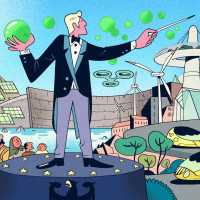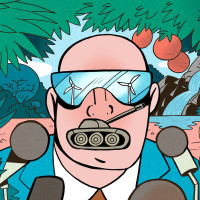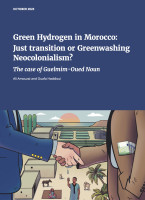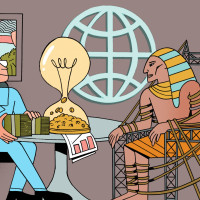Fossil Water, ‘Renewables Capitalism’ Land, Groundwater, and Solar Power in Siwa Oasis, Egypt
Regiones
At the edge of Egypt’s Sahara, Siwa Oasis stands as a paradox: solar-powered farms draw life from ancient groundwater while drowning the land they seek to cultivate. This article uncovers how green energy and agribusiness, hailed as sustainable solutions, are accelerating ecological collapse and eroding indigenous lifeways in Siwa.

Descargas
Autores
Introduction
Siwa oasis is one of the remotest agrarian settlements in Egypt, with 300 kilometres of barren desert separating it from the closest town. A long highway connects the town and a small cluster of adjacent satellite villages and hamlets of roughly 34,000 inhabitants, to Marsa Matrouh on the North Coast.1 However, the road does not extend with any substantial traffic anywhere else from this agrarian community in the middle of the arid Sahara, giving Siwa oasis the aura of a final destination - a place that feels like you are at the ‘ends of the world’ on this warming globe.
A few kilometres south of Siwa is one of many farms that sprung up over the last five decades around the oasis and introduced an increasingly intensified farming-for-export model. It is in the range of 200-300 acres (80-120 hectares). It grows dates, olives, and clover (animal fodder), with irrigation from the abundant groundwater (the great Nubian Aquifer System, NAS), that an impressive futuristic-looking solar power station pumps up from over a hundred meters underground. The farm extends on uneven terrain, with a huge dune at one of its ends, 30 meters high, away from the road that goes farther south into the northern tips of the Great Sand Sea. At that end, immediately at the foot of the dune, is a large peaceful looking pool. The pool is new, formed over the last few years and expanding, claiming more land, fed by the runoff irrigation water from the farm, that trickles ceaselessly towards that small topographical depression. Recently, the pool expanded to the extent that it leaked into the accom- modation of the dozen labourers who work on the farm. They woke one day to find water surrounding their beds. Its salty water ate away at many of the palm trees and destroyed the clover field on the farm. The more water in the pool, the more green algae accumulates on the bottom, making it harder for the water to penetrate the sand and runoff underground. This process is drowning the solar-powered farm.
This article seeks to explore and understand a scenario unfolding across the oasis that the situation of this farm echoes on a micro scale. Siwa – home to a thriving indige- nous agrarian population for hundreds of years, and home also to unique plant species not found elsewhere (local varieties of olives, dates, grapes, pomegranates, berries, and wild desert flora and fauna) – is facing the imminent threat of being drowned under the impact of the ever-expanding lakes at its centre, that continue to grow due to increasing quantities of runoff irrigation water, coming from the new farms on reclaimed desert land surrounding the oasis, powered by Photo-voltaic Cells (PVCs).
Runoff irrigation water is drowning Siwa while, historically, groundwater gave home to an agrarian community in the middle of the Sahara. The water lies at a low depression that brings it closer to the extensive NAS groundwater, and for millennia this water circulated by natural pressure upwards and sustained fertile land. The new reclaimed desert land on surrounding higher ground is currently using solar power to pump NAS groundwater, but the extra irrigation unabsorbed by the crops finds its way through gravity to the lakes close to the town’s centre and is gradually expanding.
The green technology of PVCs is powering an uneven boom in reclaiming new lands and water from the oasis. Yet this is happening while Siwan farmers are finding it increasingly challenging to access both water and land. Because of the growing dominance of the intensified export-oriented farming model in Siwa over the last five decades (accelerated further since the early 2000s), which focused on cultivating only a few varieties of palm trees and imported olive trees, several local variations of both palm and olive trees are facing extinction.
The agribusiness model of intensified mono-cropping for export is unfolding across the reclaimed uplands and replacing Siwan organic traditional farming knowledge with farming practices that depend on chemical fertilisers and pesticides. As part of these dramatic changes in farming practices, small Siwan farmers are losing their relative economic independence (growing part of their food and selling dates and olives grown on their land) as their small pieces of land deteriorate in quality, and accordingly, they become more dependent economically on the fast-expanding agribusiness that is increasingly dominating land around them, and the precarious labour market on these new more extensive and capital-intensive farms. PVCs suck the groundwater from under the feet of Siwan farmers, making expensive further investment in PVCs on their farms necessary to keep drawing even more water for irrigation that once flowed naturally without the need for investments in machine-generated power. As a consequence, their economic model of farming is threatened as developments have raised water salinity and accordingly decreases olives and dates productivity.
In this article, we ask how Siwa ended up in a situation where renewable energy accelerates socioecological collapse, in contradiction to its often-assumed sustainable role in a post-fossil fuels future. Section two lays the ground by presenting the bio-geophysical knowledge produced on Siwa’s ecological crisis, where the delicate regime of using NAS’s non-renewable groundwater in irrigation – within limits – has been disrupted and radically changed over the last 50 years. This has led to a situation of ‘displacement in place’, where economic, social, and ecological change is pulling the former somewhat stable order of the economy, society, and nature in Siwa from under the feet of its inhabitants, turning small farmers into landless hired labourers.
To simplify this intricate history, we divide the story (in section three) into three waves, across which capitalism in agricultural practices intensifies extractivism of labour and nature, while the global market dynamics penetrate further into Siwa, using solar power to extract wealth from monocrops and exploit the majority of Siwans in the process. In section four, we analyse the dynamics through which PVCs-powered water pumps are leading to mounting risks of the drowning of Siwa, while enabling the intensification of capitalist agricultural practices of commodification and redistribution of land to medium, large, and mega investors.
At the outset, we summarise our assumptions on what capitalism is, and on how it is becoming the dominant mode of production in Siwa. Capital describes determinants of ‘the creation of value by the consumption of labor power’, where the latter exists as a purchasable commod- ity. Capitalism is a descriptor of capital: a ‘concrete social formation’ in which capital assumes all matter to the value-form.2 In simpler terms, capital is the generalised production of the commodity for its exchange value, through the worker selling their labour power as a commodity.3 In relation to capital, Capitalism is “the rule of capital” over labour and nature.4
How and when capitalism came to dominate Siwa is a question we do not offer an answer to (even while we suspect that it is a process in the making), though this article contributes to its answer. How? We trace the trajectory of the agrarian means of production over the last 40-50 years, particularly the history of groundwater extraction technologies, whose development makes it possible to intensify the production from more land around the oasis. With this agenda, investigating the recent history of agrarian technology in Siwa is a useful means to examine the accelerating extension of capitalist agriculture in the oasis, because in combination with this history of developments in groundwater extraction technologies in Siwa, we see how agribusiness - as a form of ‘the generalized production of the commodity: capitalism’ (since agribusiness comes to intensify mono- cropping for outside markets, including export markets) - is increasingly dominating Siwa and introducing intensified forms of exploitation of labour and nature. This means that we are not interested in the trajectories of the transition to capitalism. Instead of stumbling across the article in defining what is capitalist and what is not in this process we describe, we assume that what is happening in Siwa -the gradual rise of the rule of capital - is a ‘complex range of lived relations and institutional permutations that variously combine different aspects of the whole in novel,dynamic and unpredictable ways.’ 5
Analysing the complex ways through which water extraction technologies developed in Siwa (culminating in solar power) shows certain aspects through which Siwa and its people are impacted by evolving capitalist agricul- ture (which we equate with ‘agribusiness’). This process is depriving the majority of Siwans from their water (man- aged as commons) and rendering their means of production obsolete, since it is increasingly becoming essential for all farmers to invest capital to access groundwater for
irrigation. This means tying their access to water and land to intensive capital investment and gradually rendering their traditional farming model impossible. It includes depriving them of their cultural tools of production – traditional farming knowledges and practices – in addition to depriving them of their native plant species and local seed varieties which have been helping Siwans to survive
for centuries. Beside turning some farmers into landless agricultural labourers, capitalism in Siwa – powered by green technologies since the mid-2010s to the present – is sourcing wealth from the non-renewable groundwater and leading to the flooding of the heart of the oasis, destroying human and non-human nature.



